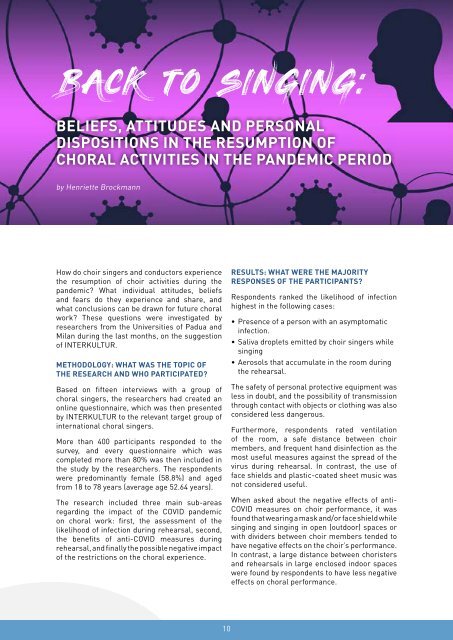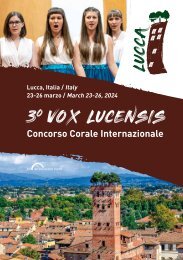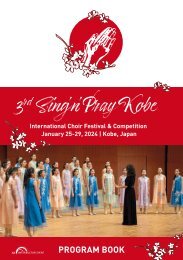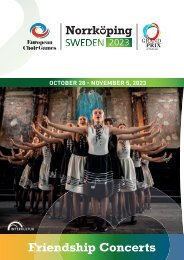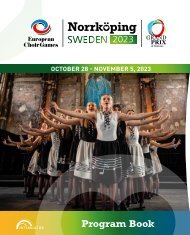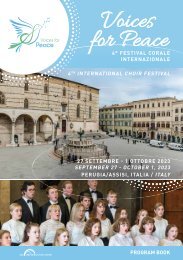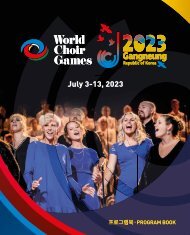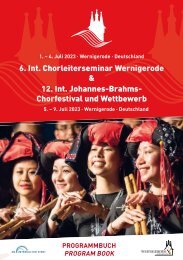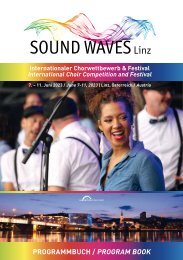COUNCIL TALK 02/2021 - The digital magazine of the World Choir Council
The digital magazine COUNCIL TALK is the magazine of the INTERKULTUR World Choir Council – in exchange with the choir world. It is published twice a year at the end of January and August. In addition to reviews of the projects and meetings of the World Choir Council, the magazine focuses primarily on current issues and challenges of the choral scene.
The digital magazine COUNCIL TALK is the magazine of the INTERKULTUR World Choir Council – in exchange with the choir world. It is published twice a year at the end of January and August.
In addition to reviews of the projects and meetings of the World Choir Council, the magazine focuses primarily on current issues and challenges of the choral scene.
- No tags were found...
Create successful ePaper yourself
Turn your PDF publications into a flip-book with our unique Google optimized e-Paper software.
BACK TO SINGING:<br />
BELIEFS, ATTITUDES AND PERSONAL<br />
DISPOSITIONS IN THE RESUMPTION OF<br />
CHORAL ACTIVITIES IN THE PANDEMIC PERIOD<br />
by Henriette Brockmann<br />
How do choir singers and conductors experience<br />
<strong>the</strong> resumption <strong>of</strong> choir activities during <strong>the</strong><br />
pandemic? What individual attitudes, beliefs<br />
and fears do <strong>the</strong>y experience and share, and<br />
what conclusions can be drawn for future choral<br />
work? <strong>The</strong>se questions were investigated by<br />
researchers from <strong>the</strong> Universities <strong>of</strong> Padua and<br />
Milan during <strong>the</strong> last months, on <strong>the</strong> suggestion<br />
<strong>of</strong> INTERKULTUR.<br />
METHODOLOGY: WHAT WAS THE TOPIC OF<br />
THE RESEARCH AND WHO PARTICIPATED?<br />
Based on fifteen interviews with a group <strong>of</strong><br />
choral singers, <strong>the</strong> researchers had created an<br />
online questionnaire, which was <strong>the</strong>n presented<br />
by INTERKULTUR to <strong>the</strong> relevant target group <strong>of</strong><br />
international choral singers.<br />
More than 400 participants responded to <strong>the</strong><br />
survey, and every questionnaire which was<br />
completed more than 80% was <strong>the</strong>n included in<br />
<strong>the</strong> study by <strong>the</strong> researchers. <strong>The</strong> respondents<br />
were predominantly female (58.8%) and aged<br />
from 18 to 78 years (average age 52.64 years).<br />
<strong>The</strong> research included three main sub-areas<br />
regarding <strong>the</strong> impact <strong>of</strong> <strong>the</strong> COVID pandemic<br />
on choral work: first, <strong>the</strong> assessment <strong>of</strong> <strong>the</strong><br />
likelihood <strong>of</strong> infection during rehearsal, second,<br />
<strong>the</strong> benefits <strong>of</strong> anti-COVID measures during<br />
rehearsal, and finally <strong>the</strong> possible negative impact<br />
<strong>of</strong> <strong>the</strong> restrictions on <strong>the</strong> choral experience.<br />
RESULTS: WHAT WERE THE MAJORITY<br />
RESPONSES OF THE PARTICIPANTS?<br />
Respondents ranked <strong>the</strong> likelihood <strong>of</strong> infection<br />
highest in <strong>the</strong> following cases:<br />
• Presence <strong>of</strong> a person with an asymptomatic<br />
infection.<br />
• Saliva droplets emitted by choir singers while<br />
singing<br />
• Aerosols that accumulate in <strong>the</strong> room during<br />
<strong>the</strong> rehearsal.<br />
<strong>The</strong> safety <strong>of</strong> personal protective equipment was<br />
less in doubt, and <strong>the</strong> possibility <strong>of</strong> transmission<br />
through contact with objects or clothing was also<br />
considered less dangerous.<br />
Fur<strong>the</strong>rmore, respondents rated ventilation<br />
<strong>of</strong> <strong>the</strong> room, a safe distance between choir<br />
members, and frequent hand disinfection as <strong>the</strong><br />
most useful measures against <strong>the</strong> spread <strong>of</strong> <strong>the</strong><br />
virus during rehearsal. In contrast, <strong>the</strong> use <strong>of</strong><br />
face shields and plastic-coated sheet music was<br />
not considered useful.<br />
When asked about <strong>the</strong> negative effects <strong>of</strong> anti-<br />
COVID measures on choir performance, it was<br />
found that wearing a mask and/or face shield while<br />
singing and singing in open (outdoor) spaces or<br />
with dividers between choir members tended to<br />
have negative effects on <strong>the</strong> choir’s performance.<br />
In contrast, a large distance between choristers<br />
and rehearsals in large enclosed indoor spaces<br />
were found by respondents to have less negative<br />
effects on choral performance.<br />
10


